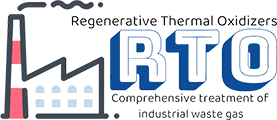RTO Thermal Oxidizer Efficiency
RTO Thermal Oxidizer Efficiency
Introduction
In the field of industrial air pollution control, regenerative thermal oxidizers (RTOs) have gained significant attention due to their high efficiency in eliminating volatile organic compounds (VOCs) and hazardous air pollutants (HAPs). The thermal oxidizer efficiency plays a vital role in determining the overall effectiveness and cost-effectiveness of RTO systems.
Factors Affecting RTO Efficiency
– Heat Recovery Efficiency:
Efficient heat recovery is crucial for maximizing the thermal oxidizer efficiency. RTOs utilize ceramic media beds to capture and store heat, which is later utilized for preheating the incoming polluted air. The design and material of the ceramic media significantly impact the heat recovery efficiency.
– Air Flow Distribution:
Proper air flow distribution within the RTO system is essential for achieving optimal efficiency. Effective distribution ensures uniform heat transfer and pollutant oxidation throughout the system. Inefficient air flow distribution can lead to hotspots and lower overall efficiency.
– Destruction Efficiency:
The destruction efficiency is a measure of how effectively the RTO eliminates VOCs and HAPs. Factors such as residence time, temperature, and pollutant concentration influence the destruction efficiency. Maintaining suitable operating conditions, such as a high temperature and adequate residence time, is crucial for achieving optimal efficiency.
– Control System Optimization:
An efficient control system is essential for maintaining the desired operating conditions and minimizing energy consumption. Advanced control algorithms and sensors help optimize the RTO’s performance, ensuring efficient pollutant destruction and reduced energy usage.
– Maintenance and Inspections:
Regular maintenance and inspections are vital for ensuring the long-term efficiency of the RTO system. Timely cleaning of the ceramic media, checking and repairing any seal or insulation issues, and conducting performance audits contribute to maintaining optimal efficiency.
Benefits of High RTO Efficiency
– Cost Savings:
A highly efficient RTO system can result in significant cost savings in terms of energy consumption. The heat recovery mechanism minimizes the need for external fuel sources, reducing operational expenses.
– Environmental Compliance:
By efficiently destroying VOCs and HAPs, RTOs help industries meet regulatory requirements and maintain environmental compliance. High thermal oxidizer efficiency ensures effective pollutant removal, minimizing the impact on the surrounding environment.
– Sustainability:
RTOs contribute to sustainable practices by reducing greenhouse gas emissions and promoting cleaner air quality. The efficient use of heat and energy aligns with sustainability goals and supports a more environmentally conscious approach to industrial processes.
– Process Optimization:
Optimizing RTO efficiency requires a thorough understanding of the process and its specific requirements. By analyzing and fine-tuning the RTO system, industries can identify opportunities for process optimization, leading to improved overall efficiency.
Conclusion
RTO thermal oxidizer efficiency plays a crucial role in the successful implementation of air pollution control measures in industries. Factors such as heat recovery efficiency, air flow distribution, destruction efficiency, control system optimization, and maintenance significantly impact the overall efficiency of RTO systems. By prioritizing efficiency, industries can achieve cost savings, environmental compliance, sustainability, and process optimization. Implementing and maintaining a high-efficiency RTO system is essential for a cleaner and more sustainable future.

Company Introduction
Our company is a high-tech equipment manufacturing enterprise specializing in comprehensive treatment of volatile organic compounds (VOCs) waste gas and carbon reduction and energy-saving technology. We have four core technologies: thermal energy, combustion, sealing, and self-control. We also have the ability to simulate temperature fields and air flow fields, as well as to test the performance of ceramic heat storage materials, molecular sieve adsorbent materials, and high-temperature incineration and oxidation of VOCs organic compounds.
We have an RTO technology R&D center and a waste gas carbon reduction engineering technology center in Xi’an, and a 30,000 square meter production base in Yangling. We are a leading manufacturer of RTO equipment and molecular sieve rotary equipment in the world. Our core technology team comes from the Aerospace Liquid Rocket Engine Research Institute, and we currently have more than 360 employees, including more than 60 R&D technical backbone employees, 3 senior engineers with researcher-level titles, 6 senior engineers, and 158 thermodynamics PhDs.
Our core products are rotating valve heat storage oxidation incinerators (RTOs) and molecular sieve adsorption concentration rotors. Combined with our own environmental protection and thermal energy system engineering technology expertise, we can provide customers with comprehensive solutions for industrial waste gas treatment and energy utilization carbon reduction for various operating conditions.
Certifications and Qualifications

- Intellectual Property Management System Certification
- Quality Management System Certification
- Environmental Management System Certification
- Construction Enterprise Qualification
- High-tech Enterprise
- Patents for Rotating Valve Heat Storage Oxidation Furnace Directional Valve, Rotary Heat Storage Incineration Equipment, and Disc Molecular Sieve Rotor
How to Choose Suitable RTO Equipment

- Determine the characteristics of waste gas
- Understand the local regulations and emission standards
- Evaluate energy efficiency
- Consider operation and maintenance
- Budget and cost analysis
- Choose the appropriate RTO type
- Consider environmental and safety factors
- Performance testing and verification
It is important to carefully consider each point when choosing suitable RTO equipment. First, determining the characteristics of the waste gas can help select the appropriate RTO type. Understanding local regulations and emission standards is necessary to ensure compliance. Evaluating energy efficiency and analyzing budget and cost can help select the most cost-effective option. Consideration of environmental and safety factors is crucial to ensure safe operation. Performance testing and verification should be performed to ensure the equipment is functioning properly.
Our Service Process
- Consultation and evaluation: Initial consultation, on-site inspection, needs analysis
- Design and scheme development: Scheme design, simulation and modeling, scheme review
- Production and manufacturing: Customized production, quality control, factory testing
- Installation and commissioning: On-site installation, commissioning and operation, training services
- After-sales support: Regular maintenance, technical support, supply of spare parts
Our one-stop solution provides customers with a customized RTO solution. We have a professional team to provide consultation, design, production, installation, and after-sales support services. Our goal is to provide customers with the best possible solution to meet their specific needs.
Author: Miya
